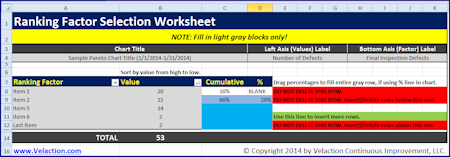Pareto Principle
The Pareto principle is the result of the work of the 19th Century economist, Vilfredo Pareto. He realized that wealth in Italy was distributed unevenly, and mathematically proved his observation.
Today, the Pareto principle is more commonly known as the 80-20 rule. Simply put, 80 percent of problems are the result of 20 percent of the causes. The power of the Pareto principle is immense. It conserves resources by letting you focus on a small number of issues to eliminate a disproportionally large number of problems.
Of note, the numbers 80 and 20 are not set in stone. It often turns out to be 70-35 or 90-12. Also note that since the percentages are of two different things (causes and effects) they do not have to add up to 100.
The most common way of displaying the Pareto principle is on the Pareto chart.
![]()


